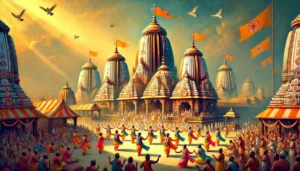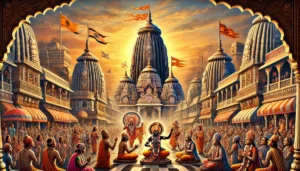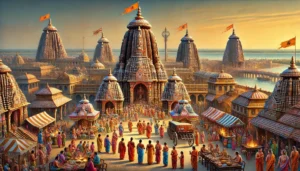
The Role of Jagannath Puri in the Bhakti
The Role of Puri in the Bhakti Movement
The Bhakti Movement, which emphasized devotion (bhakti) as the primary means of attaining salvation, played a transformative role in Indian spirituality between the 7th and 17th centuries. This movement sought to break barriers of caste, ritualism, and rigid orthodoxy by promoting a personal and emotional connection with the Divine.
Among the many sacred centers associated with this movement, Puri, located in the present-day Indian state of Odisha, became a pivotal hub for Vaishnavism and devotional traditions. The presence of the world-famous Jagannath Temple, the influence of saints like Chaitanya Mahaprabhu, and the inclusive nature of worship made Puri a beacon of the Bhakti Movement.
Puri: The Abode of Lord Jagannath
Puri is one of the four sacred char dhams of Hinduism (the others being Badrinath, Dwarka, and Rameswaram). It is primarily associated with the worship of Lord Jagannath, a form of Vishnu/Krishna, whose idol is characterized by large round eyes and a unique, aniconic form.
The Jagannath Temple has long been considered a spiritual melting pot where devotion transcends caste, sectarian differences, and social divisions. Unlike many other Hindu temples, where only Brahmins performed rituals, the Jagannath temple involved Daitapatis, a class of non-Brahmin temple servitors, in key religious functions. This emphasized inclusivity, a core principle of the Bhakti tradition.
Rath Yatra: A Bhakti Movement in Motion
One of the most significant expressions of bhakti in Puri is the Rath Yatra (Chariot Festival), an annual event where the deities Jagannath, Balabhadra, and Subhadra are taken in massive chariots from the temple to the Gundicha Temple, a symbolic homecoming for the deities.
The Rath Yatra is deeply connected with the Bhakti Movement’s ideals:
1. The festival allows devotees from all backgrounds, including those who might not be permitted inside the temple, to see and worship the deities.
2. The tradition of sweeping the chariot path (Chhera Pahanra) by the Gajapati king of Puri reinforces the idea that all are equal before God.
3. Devotees express their love for Lord Jagannath through bhajans, kirtans, and dance, mirroring the bhakti traditions of community worship seen across India.
Chaitanya Mahaprabhu and the Bhakti Movement in Puri
One of the most significant figures to be associated with Puri’s role in the Bhakti Movement was Chaitanya Mahaprabhu (1486–1534), a mystic saint and key proponent of Gaudiya Vaishnavism.
Chaitanya Mahaprabhu, believed to be an incarnation of Krishna, renounced worldly life and settled in Puri, where he spent the last 18 years of his life in deep spiritual ecstasy. His teachings and practices transformed Puri into a vibrant center of bhakti, spreading his influence beyond Odisha to Bengal, Assam, and even Vrindavan.
Table of Contents

The Role of Jagannath Puri in the Bhakti
Chaitanya’s Contributions to Bhakti in Puri
1. Harinama Sankirtan: Devotion Through Song and Dance
Chaitanya Mahaprabhu popularized the practice of Harinama Sankirtan, the congregational chanting of the Hare Krishna mantra:
“Hare Krishna, Hare Krishna, Krishna Krishna, Hare Hare,
Hare Rama, Hare Rama, Rama Rama, Hare Hare.”
His ecstatic singing and dancing in the streets of Puri brought together people from all backgrounds, breaking social and caste barriers. This practice became a fundamental aspect of the Gaudiya Vaishnava tradition, which later influenced the International Society for Krishna Consciousness (ISKCON) in modern times.
2. Jagannath Worship and Spiritual Ecstasy
Chaitanya was deeply devoted to Lord Jagannath and frequently experienced divine ecstasy (bhava samadhi) during the Rath Yatra. His intense spiritual experiences during these festivals inspired thousands, reinforcing the Bhakti Movement’s emphasis on personal and emotional devotion over ritualistic practices.
3. Unity and Inclusivity in Worship
Chaitanya’s interactions with people from different backgrounds, including saints, scholars, and even non-Hindus, helped foster a more inclusive spiritual environment in Puri. He engaged in philosophical discussions with Ramananda Raya, a minister in the court of the Gajapati king of Odisha, and encouraged devotion beyond caste and class distinctions.
4. Literary and Philosophical Contributions
Puri, under Chaitanya’s influence, became a hub for devotional literature and philosophy. Many of his followers, including Rupa Goswami, Sanatana Goswami, and Jiva Goswami, wrote foundational texts of Gaudiya Vaishnavism, such as:
• Bhakti-rasamrita-sindhu (by Rupa Goswami) – defining different forms of bhakti (devotion)
• Hari-bhakti-vilasa – outlining Vaishnava rituals and practices
• Chaitanya Charitamrita (by Krishnadasa Kaviraja) – chronicling Chaitanya Mahaprabhu’s life and teachings
Jagannath Temple: A Magnet for Bhakti Saints
Apart from Chaitanya Mahaprabhu, many other saints visited and contributed to Puri’s role in the Bhakti Movement:
• Adi Shankaracharya (8th century): Established the Govardhan Math, linking Puri to his Advaita Vedanta tradition while acknowledging devotion (bhakti) as a valid spiritual path.
• Ramanujacharya (11th century): Preached Vishishtadvaita (qualified non-dualism) and encouraged a more personal and loving devotion to Vishnu, influencing Jagannath worship.
• Kabir (15th century): The mystic poet visited Puri and criticized empty ritualism, advocating direct devotion to God without intermediaries.
• Guru Nanak (1469–1539): The founder of Sikhism visited Puri and engaged in philosophical discussions with the local saints, reinforcing interfaith harmony.
Impact of Puri on the Bhakti Movement
1. A Symbol of Bhakti Beyond Caste and Creed
Puri’s Jagannath Mahaprasad, prepared in the temple’s massive kitchen, is considered sacred and is shared among people from all backgrounds, symbolizing the Bhakti Movement’s emphasis on equality in devotion.
2. Spreading Bhakti Across India
Saints who visited Puri carried its bhakti traditions to Bengal, Maharashtra, North India, and South India, strengthening regional bhakti movements.
3. A Living Bhakti Tradition
Even today, Puri remains a vibrant center for Vaishnavism, kirtan, and pilgrimage, continuing the legacy of the Bhakti Movement.

The Role of Jagannath Puri in the Bhakti
Conclusion
Puri’s role in the Bhakti Movement goes beyond its identity as a sacred city. It became a melting pot of devotion, social transformation, and spiritual evolution. The presence of Lord Jagannath, the impact of Chaitanya Mahaprabhu, and the teachings of numerous saints made it a lighthouse of bhakti, inspiring millions over centuries.
Even in the modern age, the chants of Hare Krishna, the celebration of Rath Yatra, and the distribution of Mahaprasad continue to keep Puri’s bhakti spirit alive. The city remains a timeless testimony to the power of devotion that transcends caste, creed, and social barriers, making it one of the greatest centers of the Bhakti Movement in India.
FAQs on “Puri: A Sacred Hub of the Bhakti Movement”:
1. Why is Puri considered an important center of the Bhakti Movement?
Puri is home to the Jagannath Temple, one of the Char Dham pilgrimage sites, and a major center for Vaishnavism. It attracted many Bhakti saints like Chaitanya Mahaprabhu, who spread devotional teachings emphasizing surrender to God, equality, and love.
2. How did Chaitanya Mahaprabhu contribute to the Bhakti Movement in Puri?
Chaitanya Mahaprabhu spent many years in Puri, engaging in devotional worship of Lord Jagannath and spreading the ideals of Gaudiya Vaishnavism. His teachings focused on Nama Sankirtana (chanting the holy names), which became a key practice in the Bhakti Movement.
3. What role did the Jagannath Temple play in the Bhakti Movement?
The Jagannath Temple became a unifying force for devotees from different social backgrounds. It symbolized inclusivity and devotion, as seen in the annual Rath Yatra, which allowed people of all castes to participate in the worship of Lord Jagannath.
4. Were there other Bhakti saints associated with Puri?
Yes, apart from Chaitanya Mahaprabhu, many saints like Jayadeva (author of Gita Govinda), Ramananda, and Achyutananda were connected to Puri, enriching its Bhakti traditions through poetry, music, and spiritual teachings.
5. What impact did the Bhakti Movement in Puri have on Indian society?
The Bhakti Movement in Puri challenged caste barriers, promoted devotion over rituals, and influenced regional literature, music, and temple traditions. It inspired a deeper emotional and personal connection with the divine.
6. How is the legacy of the Bhakti Movement preserved in Puri today?
Puri continues to be a major pilgrimage site where traditions of devotional singing (kirtans), temple rituals, and festivals like Rath Yatra keep the Bhakti spirit alive. The teachings of Chaitanya Mahaprabhu and other saints still inspire millions of devotees.
7. How did Puri influence the spread of Bhakti traditions beyond Odisha?
Puri attracted devotees from different parts of India, including Bengal, Andhra Pradesh, and Maharashtra. The teachings of saints like Chaitanya Mahaprabhu spread through his disciples, leading to the rise of Gaudiya Vaishnavism and influencing Bhakti traditions across the country.
8. What is the significance of Rath Yatra in the Bhakti tradition?
Rath Yatra, the grand chariot festival of Lord Jagannath, embodies the core principles of Bhakti—devotion, inclusivity, and surrender to the divine. It allows devotees from all backgrounds to actively participate in the divine journey, reinforcing the Bhakti Movement’s ideals of unity and spiritual equality.
9. How did Bhakti poets and saints contribute to Puri’s spiritual heritage?
Many Bhakti poets, including Jayadeva, wrote devotional hymns and texts in praise of Lord Jagannath. Their compositions, such as Gita Govinda, were incorporated into temple rituals, enriching Puri’s spiritual and cultural heritage through music and poetry.
10. How does Puri’s connection with the Bhakti Movement continue to inspire modern spirituality?
Puri remains a center for devotional practices like kirtan, meditation, and pilgrimage. Gaudiya Vaishnavism and Jagannath worship continue to inspire spiritual seekers worldwide, keeping the Bhakti Movement’s legacy alive in contemporary times.
Summary
Puri, one of India’s most revered pilgrimage sites, played a pivotal role in the Bhakti Movement, which emphasized personal devotion, love for God, and spiritual inclusivity over rigid rituals and caste barriers. As the sacred abode of Lord Jagannath, Puri became a magnet for saints, poets, and devotees from across the subcontinent, fostering a spiritual environment that deeply influenced Bhakti traditions.
Several renowned spiritual leaders, including Adi Shankaracharya, Ramanuja, Madhvacharya, and Chaitanya Mahaprabhu, left their mark on Puri’s religious landscape. Among them, Chaitanya Mahaprabhu’s influence was particularly profound—he spent his final years in Puri, engaging in ecstatic kirtans (devotional singing) and spreading the ideals of Gaudiya Vaishnavism, which emphasized surrender to Krishna through love and devotion. His presence turned Puri into a center for devotional practices, attracting followers from different regions and backgrounds.
The grand Rath Yatra (chariot festival) of Lord Jagannath became a significant symbol of Bhakti’s inclusivity, where people of all castes and communities participated in pulling the deity’s chariot, reinforcing the movement’s emphasis on universal devotion. Additionally, Puri’s monastic institutions, including the Govardhan Math established by Adi Shankaracharya, played a vital role in shaping philosophical discourse and Bhakti traditions.
Beyond its religious importance, Puri nurtured a rich tradition of devotional literature and music, further spreading Bhakti ideals. Through its vibrant spiritual atmosphere, temple rituals, and historical connections to key Bhakti saints, Puri became not just a pilgrimage destination but a thriving center of devotional worship and religious reform.
Unlock the Ancient Wisdom of Sanatan Dharma – Join Us on YouTube!
👉 Subscribe now to Prachin Sanatan Dharma and embark on a journey of enlightenment.
Explore timeless teachings, spiritual insights, and cultural richness on our YouTube channel, Prachin Sanatan Dharma. Dive deep into the essence of Sanatan Dharma through captivating videos that inspire and educate.
Related Articles
- Restful Nights: Ayurvedic Remedies and Traditional Indian Practices to Overcome Insomnia and Late-Night Habits
- The Tridevi: Lakshmi, Saraswati, and Parvati – Their Roles and Powers
- “Divine Creatures of Ancient Indian Scriptures: Exploring the Role of Animals in the Vedas, Puranas, and Mahabharata”
- Nature and Spirituality: Exploring the Sacred Essence of the Himalayas, Ganga, and Other Natural Wonders”
- “Reviving the Gurukul System: Relevance and Lessons for Modern Education”
- “Exploring Greek and Indian Mythology: Similarities Between Greek and Indian Mythology “
- “Embracing Sattvic Living: Harmonizing Mind, Body, and Soul Through Food and Lifestyle”
- “Charity and Prosperity: Exploring the Concept of Daan and Its Financial Relevance in Modern Life”
- How to Build an Eco-Friendly Home Inspired by Vastu Shastra
- Comparison of Ancient and Modern Sports: How Traditional Sports Have Influenced Contemporary Games
- “Timeless Lessons from Ancient Tales: Linking Samudra Manthan and Ganga’s Descent to Modern Ecological Challenges”
- “Reviving Sanskrit: How AI is Preserving Ancient Languages for the Future”
- “Mathura: The Sacred Land of Lord Krishna’s Divine Leelas”
- Investing for Future Generations: Lessons from Indian Traditions on Legacy Building and Wealth Preservation
- “Ancient Indian Wisdom: Timeless Lessons for Tackling Today’s Climate Crisis”
- “Artificial Intelligence and Spirituality: Transforming Ancient Practices for the Modern World”
- “Gold and Real Estate in India: Timeless Assets Shaping Financial Strategies”
- Tradition Meets Innovation: The Evolution of Technology in Hindu Rituals
- End-of-World Myths: Exploring Kali Yuga in Hinduism and Ragnarök in Norse Mythology
- Garuda, Pegasus, and Dragons: The Universal Ties of Mythical Beasts Across Cultures
- “Ancient Vimanas: Mythical Flying Machines or Evidence of Advanced Technology?”
- Time Travel in Hindu Mythology: The Fascinating Tales of Kakudmi and King Raivata
- “Divine Feminine Power in Hindu Mythology: The Legends of Durga, Saraswati, and Lakshmi”
- “Divine Beings of Sanatan Dharma: The Spiritual Significance of Sacred Animals in Hinduism”
- “Symbolism in Mythological Art: Unlocking Hidden Meanings in Ancient Temple Carvings”
- “Exploring Technological Advancements in Ancient India and Civilizations: Vimana, Metallurgy, & Water Management systems”
- Unveiling the Mysteries: Ancient Temples of Sanatan Dharma , Mysterious Temples of India
- “The Scientific Knowledge of Sanatan Dharma: Ancient Wisdom Meets Modern Science”
- Ancient Indian Sports and Games: Celebrating a Legacy of Skill, Strength & Strategy”
- “Exploring the Cosmic Link: The Connection Between Astronomy and Vedic Astrology”
- The Power of Sanskrit: Unlocking the Divine Language of the Gods
- “The End of Kaliyuga: A Sanatan Insight into the World’s Final Chapter”
- Explore more articles on Prachin Sanatan Yuga.
The Role of Jagannath Puri in the Bhakti The Role of Jagannath Puri in the Bhakti The Role of Jagannath Puri in the Bhakti The Role of Jagannath Puri in the Bhakti The Role of Jagannath Puri in the Bhakti The Role of Jagannath Puri in the Bhakti The Role of Jagannath Puri in the Bhakti The Role of Jagannath Puri in the Bhakti The Role of Jagannath Puri in the Bhakti The Role of Jagannath Puri in the Bhakti
The Role of Jagannath Puri in the Bhakti The Role of Jagannath Puri in the Bhakti The Role of Jagannath Puri in the Bhakti The Role of Jagannath Puri in the Bhakti The Role of Jagannath Puri in the Bhakti The Role of Jagannath Puri in the Bhakti The Role of Jagannath Puri in the Bhakti The Role of Jagannath Puri in the Bhakti The Role of Jagannath Puri in the Bhakti The Role of Jagannath Puri in the Bhakti
The Role of Jagannath Puri in the Bhakti The Role of Jagannath Puri in the Bhakti The Role of Jagannath Puri in the Bhakti The Role of Jagannath Puri in the Bhakti The Role of Jagannath Puri in the Bhakti The Role of Jagannath Puri in the Bhakti The Role of Jagannath Puri in the Bhakti The Role of Jagannath Puri in the Bhakti The Role of Jagannath Puri in the Bhakti The Role of Jagannath Puri in the Bhakti

